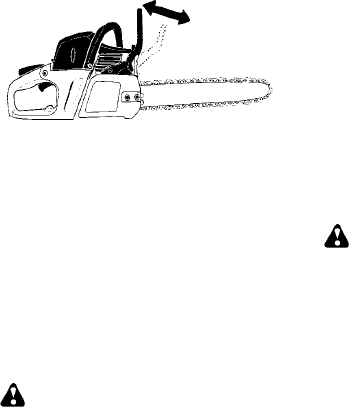
11
S This saw is equipped with a chain brake.
The brake is designed to stop the chain if
kickback occurs.
S The inertia--activated chain brake is
activated if the front hand guard is pushed
forward, either manually (by hand) or
automatically (by sudden movement).
S If the brake is already a ctivated, it is
disengaged by pulling the front hand guard
back toward the front handle as far as
possible.
S When cutting with the saw,the chain br ake
must be disengaged.
Engaged
Disengaged
Braking function control
CAUTION:
The chain brake m ust be
checked several times daily. The engine
must berunning when performingthis proce-
dure. This is the only instance when the saw
should be placed on the ground with the en-
gine running.
Place the saw on firm ground. Grip the rear
handlewithyour righthand andthe f ronthan-
dle with your left hand. Apply full throttle by
fully depressing the throttle trigger. Activate
the chain brake by turning your left wrist
against the h and guard without releasing
your grip around the front handle. The chain
should stop immediately.
Inertia activating function control
WARNING: When performing the
following procedure, the engine must be
turned off.
Grip the rear handle with your right hand and
the front handle with your left hand. Hold the
chain saw approximately 14″ (35 cm) above a
stump or other wooden surface. Release your
grip on the front handle and use the weight of
the saw to let the ti p of the guide bar fall forward
and contact the stump. When the tip of the bar
hits the stump, the brake should activate.
OPERATING TIPS
S Check chain tension before first use, after
1 minute of operation, and each tim e be-
fore you start the chain saw . See CHAIN
TENSION in the ASSEMBLY section.
S Cut wood only. Do not cut metal, plastics,
masonry , non-wood bui ldin g materia ls, etc.
S Stop the saw if the chain strikes a foreign
object. Inspect the saw and repair or re-
place parts as necessary. I f the chain
jumps off the guide bar, inspect the chain
for damageddrive links before reinstalling.
Burrs on drive links, which prevent them
from entering the groove of the guide bar,
can be removed with a flat file.
S Keep the chain out of dirt and sand. Even a
small amount of dirt will dull a chain, increase
the possibility of kickback, a nd require chain
sharpening or replacement.
S Practice cutting a few small logs using the
following techniques to get the “feel” of us-
ing your saw before you begin a major
sawing operation.
S Squeeze the throttle trigger and allow the
engine to reach full speed before cutting.
S Begin cutting with the saw frame
against the log.
S Keep the engine at full speed the entire
time you are cutting.
S Allowthe chainto cutfor you. Exert only
light downward p ressure. If you force
the cut, damageto the bar,chain, or en-
gine can result.
S Release the throttle trigger as soon as
the cut is completed, allowing the en-
gine to idle. If you run the saw at full
throttle without a cutting load,unneces-
sary wear can occur to the chain, bar,
and engine. It is recommended that
the engine not be operated for lon-
ger than 30 seconds at full throttle.
S Toavoid losingcontrolwhencut iscom-
plete, donot putpressure onsaw atend
of cut.
S Stop the engine before setting the saw
down after cutting.
TREE FELLING TECHNIQUES
WARNING: Check for broken or
dead branches which can fall while cutting
causing serious injury. Do not cut near build-
ings or electrical wires if you do not know the
direction of tree fall, nor cut at night since you
will not be ale to see well, nor during bad
weather such as rain, snow , or strong winds,
etc. If the tree makes contact with any utility
line, the utility company should be notified im-
mediately.
S Carefully planyour sawingoperation inad-
vance.
S Clearthework a rea. Youneed aclear area
all aroundthe tree so you can have secure
footing.
S The chain saw operator should keep on
the uphill side of the terrain as the tree is
likely toroll or slidedownhill afterit is felled.
S Study the natural conditions that can cause
the tree to fall in a particular direction.
Natural conditions that can cause a tree to
fall in a particular direction include:
S The wind direction and speed.
S The lean of the tree. The lean of a tree
might not be apparent due to uneven or
sloping terrain. Use a plum b o r level to de-
termine the direction of tree lean.
S Weight and branches on one side.
S Surrounding trees and obstacles.
Look for decay and rot. If the trunk is rotted,
it can snap and fall toward the operator.
Check for broken or dead branches which
can fall on you while cutting.
Make sure there is enough room for the tree to
fall. M aintain a distance of
2-1/2 t ree lengths
from the nearest person or other objects. En-
gine noise can drown out a warning call.
Remove dirt, stones, loose bark, nails, sta-
ples, and wire fromthe tree wherecuts are t o
be made. Plan a clear retreat path to therear
and diagonal to the line of fall.


















